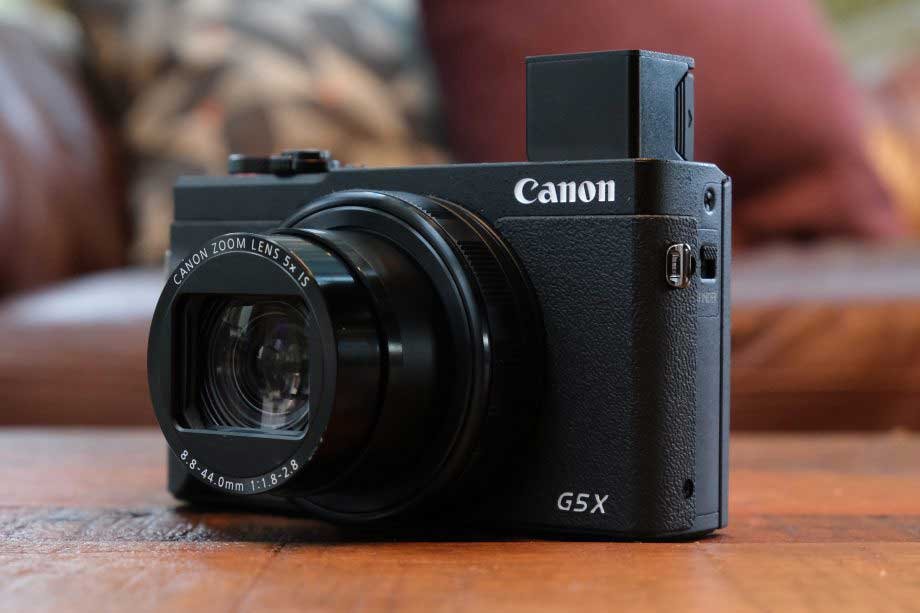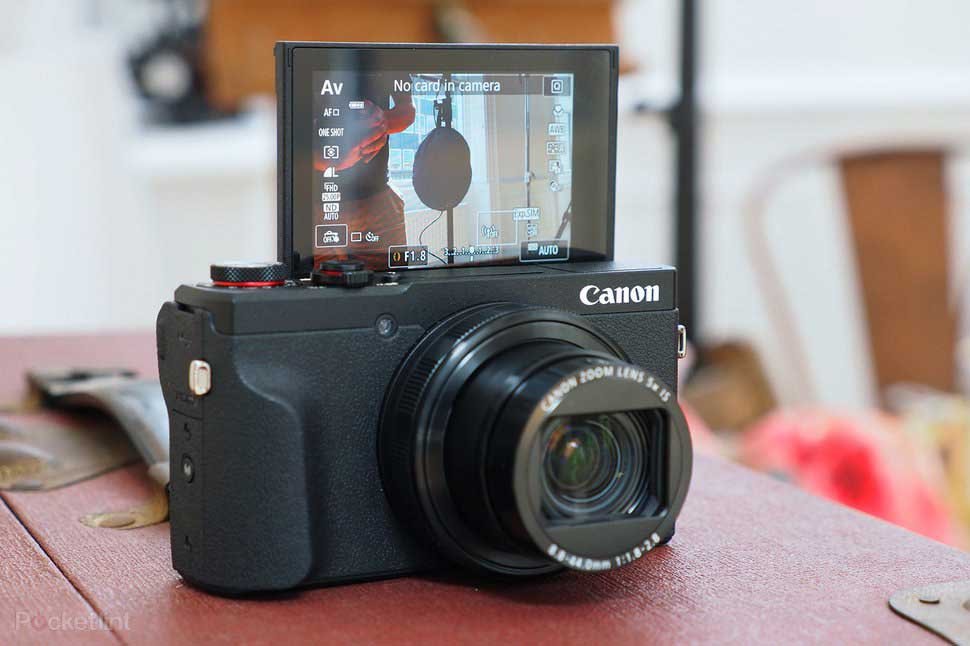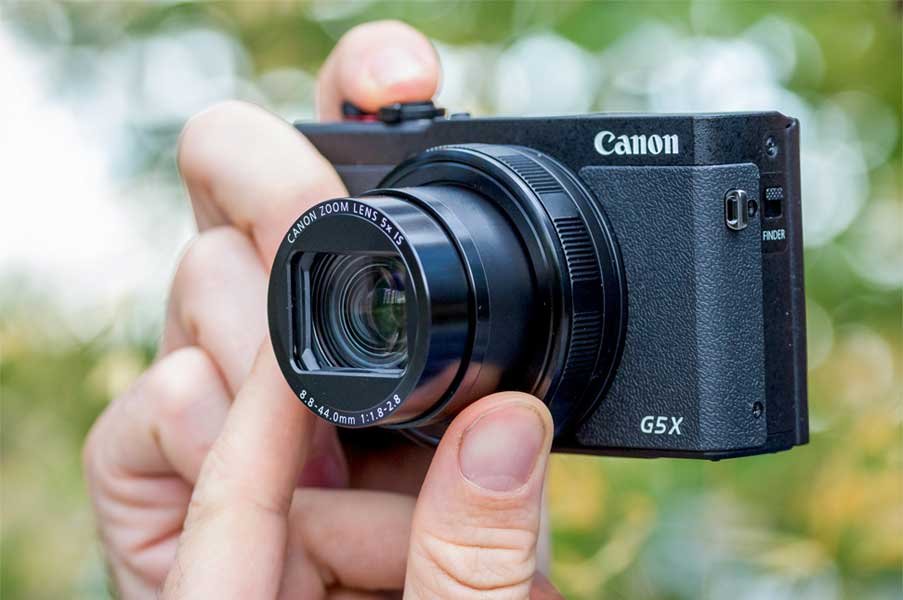The Canon PowerShot G5 X II manages to blend its capable core with some useful features, great handling, a fine build and a strong level of control. It’s an enjoyable camera to use, but it can’t be said to stand out against key competitors. Should its price fall, however, it will be far more appealing for the enthusiast looking to travel light.
Canon PowerShot G5 X Mark II Review and Features

The Canon PowerShot G5 X Mark II is not the typical Mark II update that we usually see with this type of compact camera. Sure, it arrives with a handful of improvements to the spec sheet that we may have expected, but its completely different design signals different intentions – and with it, potentially a different kind of use too.
Things have moved on inside the camera too. Canon has made a handful of changes to the imaging pipeline, fitting the model with a new 20.1MP stacked 1-inch CMOS sensor, and with the company’s latest DIGIC 8 processing engine driving things. This also allows for 4K video recording, and Canon notes that this happens without any crop factor – a common complaint on cameras of all classes that record 4K video.
This, in turn, means the wide-angle view of the lens can be maintained during video recording. The lens itself is a new optic, one that offers a focal range equivalent to 24-120mm in 35mm terms, and a respectably wide maximum aperture of f/1.8-2.8, together with lens-based image stabilization that claims a four-stop compensatory effect.
The body has been fitted with a 2.36 million-dot EVF and a 3-inch LCD screen that can be tilted downwards and upwards, and all the way around to face the front when necessary. An eye sensor positioned just above the LCD also means that the camera can automatically switch the feed between the two as it detects you looking from one to the other.
Other new features included a 30fps raw burst mode, that sits aboard a 20fps regular burst mode, while a 31-point contrast-detect AF system, Wi-Fi, Bluetooth and USB charging have additionally all been thrown into the combination.

Design-wise, gone is that the G5 X’s DSLR-like styling, and in steps a lot of efficient bodies, one that also offers an outlined grip and physical controls, however with its concealed EVF keeping it as transportable as potential once not in use. This apes the design of previous Sony RX100 models and makes the camera so much easier to squeeze into a pocket, though the grip will
With a DIGIC 8 processor on board, the camera is spirited in use. The rear command dial/menu pad allows you to zip through the EOS-style menus really quickly, though you’ll use the responsive touchscreen for fast possibility choice too. The screen responds even as well once used to set the main focus point, with simply a small delay once swiping through captured pictures.
Focusing is usually nice and brisk, and also the focus tracking system will well to stick to subjects. Face detection is additionally quick, and will well to identify smaller subjects, while the image stabilization system is additionally clearly effective, serving to deliver crisper pictures and a lot of stable feed as you are composing pictures.
Also Read: Canon PowerShot G5 X Mark II Digital Camera Price in Bangladesh
Image quality is usually excellent too, with reliable exposures, and also the ability to decide on from Canon’s established image styles helps you to get the results you would like with minimal fuss. The lens will be a touch soft at its wider focal lengths and wider apertures, however, and this additionally offers 4K videos some softness; once you zoom in and shut down the aperture, things look significantly higher. Noise is additionally well controlled, though it is a smart plan to either deactivate noise reduction or switch to the bottom setting because the default normal choice could be a very little aggressive.
Overall, the G5 X Mark II may be a beautiful camera to handle and use, and its all-round feature set means that it will handle a large range of scenes while not a lot of hassle. Its price is just too steep straight away, though, significantly once you think about the strong performance of a number of the camera’s rivals.
Lens, New sensor and Fresh Pocessing Power

The PowerShot G5 X Mark II mirrors the previous PowerShot G5 X is providing a 20MP 1-inch sensor, though the one here is new. We know this because it has a stacked design, much like the ones inside more recent generations of Sony RX10 and RX100 cameras.
The lens is also new, covering a focal range of 24-120mm (in 35mm terms) and with a respectable f/1.8-2.8 maximum aperture, while lens-based image stabilization to the tune of four stops is also on hand. This DIGIC 8 engine also brings with it Canon’s CR3 raw format, a more efficient alternative to the full-fat raw format that’s also provided here.
While the previous PowerShot G5 X was just capable of capturing videos full HD, the G5 X Mark II arrives with 4K shooting into 30p. Outside of the 16:9 aspect ratio used for capturing 4K UHD footage, there’s no crop factor here, which means you retain the same angle of view as when shooting stills. Unlike on the new PowerShot G7 X Mark III, however, you can’t hook an external microphone to the camera in any way.
Other video-based features included 4K timelapse shooting and an inbuilt ND filter to assist control exposure once shooting in brighter lightweight (or for long exposures). you furthermore might have the ability to capture footage at 120fps full HD for slow-motion output.
The camera’s focusing system could appear a bit dated, being a contrast-detect AF system with solely thirty-one points once left to its own devices, though you’ll touch the screen to possess the camera focus on that time within the scene. Face detection, focus bracketing and focus peaking also are all accessible.
As within the PowerShot G5 X, Wi-fi is on board, and this can be currently joined by Bluetooth. there is a single card slot at the base of the camera that accepts SDHC and SDXC cards to the UHS-1 normal, and a USB-C port and micro HDMI-out on the aspect of the camera.
Read More Review: Canon PowerShot SX70 HS Review
>> Canon EOS 800D DSLR Camera Review
Battery life is fairly modest at around 230 shots per charge, and simply 180 once using the EVF, though like all cameras, what you’ll be able to reach in real-world use are on top of the figures recommend because of the method they are calculated. Canon reckons that with the Eco mode enabled you will be able to enjoy battery life nearer to 320 frames.
Revamped Design with Integrated EVF

The PowerShot G5 X Mark II‘s build quality feels superb overall, with lots of attention to detail around all the controls, and enough rubber used on the front plate and rear to provide a secure hold. the only factor that lets the camera down here is that the feel of the control ring round the lens, that is good and deep however terribly coarse in its increments, with a somewhat hollow feel once turned; it isn’t a deal-breaker, though, and also the indisputable fact that it’s clicked means that you get smart feedback once turning it.
The 2.36 million-dot EVF is stowed within the high plate once not in use, and you release this via a catch at the aspect. you furthermore might need to pull it back before use and push it forwards before stowing it once more, that could be a slight inconvenience however no a lot of.
It would are understandable for such an EVF to return at the expense of an inbuilt flash, as is usually the case, however, Canon has impressively managed to squeeze each into the body here.
The EVF itself is absolutely smart for a camera of this level; it is not as spectacular nor as massive as those on the recent breed of mirrorless cameras, however, it’s moderately clear and elaborate. It even will well in brighter conditions, wherever you may expect to possess to cup your hand around it.
The LCD underneath the EVF could be a 3-inch touchscreen with 1.04 million dots, and, as we’d expect, it’s absolutely sensitive to the touch. Its profile is good and slim, and its degree of movement is great; having it mounted on such a long bracket not just only permits you to drag it up to face the front however additionally down sufficiently to enable the camera to be used well higher than head height.
An eye sensing element simply on top of the LCD tells the camera once to switch between the LCD and EVF, and there is really very little delay here.
Focusing is usually nice and speedy, even in darker conditions. it isn’t quite instant, but, as is usually the case, not thus slow that it makes any difference in observe.
The G5 X Mark II additionally will well to stay a lock on subjects as they move around the scene, while face detection additionally works well, quickly finding out subjects and sticking to them as they move.
The camera will capture pictures at terribly respectable 20fps once shooting conventionally, and while you do not get the luxurious of autofocus as this happens, the buffer depth of around 45-49 raw and JPEG frames is dead respectable. These take around 15 seconds to be flushed away to the quickest SDHC card we might get our hands-on, which is intelligible.
Image quality

With the advantage of EOS-style control and in-camera raw process, it’s potential to require an excellent deal of control over image capture and output from the PowerShot G5 X Mark II.
The metering system seems to behave predictably, giving most scenes the proper balance between shadows, highlights, and mid-tones. In some high-contrast scenes although, like those with darker foreground details and clouds overhead, you will need to either active Highlight Tone Priority or use exposure compensation to stop brighter details from being lost.
The lens will be a bit soft at its widest apertures, significantly at the wide-angle finish and at the edges of the frame, however, things improve markedly once you zoom in and shut down the aperture.
Distortions are usually well-controlled, though lateral chromatic aberration, that shows up as color fringing on the edges of details towards the edges of the frame, is kind of clear in raw files – this could be simply corrected, though.
Noise performance is usually as we’d expect from a camera with a 1-inch sensor – that’s, superb within the three-figure ISO range, and with usable leads to the lower reaches of the four-figure settings. Some could realize the default level of noise reduction to be a bit heavy-handed in some scenes, therefore you will need to knock this right down to the Low setting, or method noise out of raw pictures.
The quality of 4K videos is usually smart – not quite as crisp because it might be, however absolutely respectable for a camera of this type. There are minimal artifacts present in footage, and while there is some rolling shutter as you progress around the scene, with moderate movement at wider focal lengths it is not a problem.
The focus will be force terribly smoothly between 2 points within the scene once using the touchscreen, while the flexibility to turn an ND filter is additionally terribly helpful once shooting in bright light-weight, as you are otherwise forced to use too quick shutter speed to stay motion looking natural.
Smart Sharing

Use your mobile device* to shoot remotely, and edit and share photos on the move. The PowerShot G5 X Mark II maintains a constant Bluetooth®** link, and transfers files using Wi-Fi.
Who can buy it and why?
The Canon PowerShot G5 X Mark II is aimed toward the type of photographer who expects a regular image quality beyond the norm for a compact camera, a lot of nearer to what you’d expect from a DSLR or mirrorless model. With a pop-up viewfinder, physical dials and a control ring round the lens, it’s good for people who need to own most manual management over their picture-taking, instead of hopping on touchscreens and auto settings.
Conclusion
The Canon Powershot G5 X II could be a radical departure from what we saw within the G5 X. It’s slimmed down, concealed its viewfinder and gained some helpful new tech on the within, with the new processor allowing everything from 30fps raw shooting to 4K video. Battery life might be higher, on the other hand, the penalty here is somewhat expected once you think about the presence of an EVF, mechanical image stabilization, and also the effort to create the camera this compact (hence a physically smaller battery).
Build quality is usually excellent, and handling simply|is simply} as spectacular once you consider just however petite the camera is. The G5 X II responds fine to inputs and does not lag in any important areas, and it’s nice to possess most of the control that we’re used to from Canon’s Eos cameras in such a compact model. there is additionally very little to gripe about with the viewfinder or LCD screen, with each considerably appropriate a camera of this type in terms of their specs and performance.




